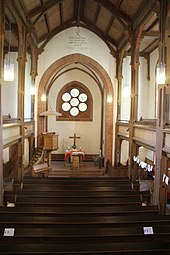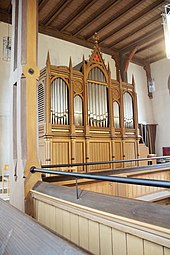Evangelical Church (Burgsolms)
The Evangelical Church in Burgsolms in the town of Solms in the Lahn-Dill district ( Hesse ) is a listed hall church . It was built in the year 1883/1884 in the neo-Gothic style.
history
The Lorsch Codex mentions the donation of a church on Solmsbach ("Sulmissa") in 788, although it is not clear whether Oberndorf or Burgsolms is meant. The fact that this was the mother church of Burgsolms speaks for Oberndorf. For Burgsolms, the fact that the crypt of a Carolingian church and a Carolingian ring wall was discovered during construction work on the parish hall at the "Free Stone" in the 1950s . The finds are part of a fortified royal court ("curtis"), which obviously served to secure the Lahn crossing.
The original patronage is not known. In the pre-Reformation period, Oberndorf and Burgsolms formed a common parish , probably without any further branch churches. In the Middle Ages it belonged to the Archipresbyterat Wetzlar in the Archidiakonat St. Lubentius Dietkirchen in the Archdiocese of Trier . Under Heinrich IV zu Solms-Braunfels († 1311/1312) the branch relationship was reversed for unknown reasons and Oberndorf branch church of Burgsolms. The Koblenz official objected to the transfer of the baptismal font from Oberndorf, which later nevertheless came to Burgsolms. In 1388, the Burgsolmser church is called the parish church.
With the introduction of the Reformation , the parish changed to the evangelical creed under Pastor Heinrich Rosarius in 1549 and used the medieval church for its own purposes. Under Count Konrad von Solms-Braunfels, the “Post Reformation” was decided on September 7, 1582 at the Hungen Synod and the Solms pastors accepted the Reformed Confession. During the Thirty Years' War , the community became Catholic for a few years from 1626 until the Swedes made it possible to practice the Protestant faith again in 1632.
Due to structural damage, the building supervisory authority ordered the church to be closed in March 1883. The community decided to build a new building above the old church according to plans by district builder Wilhelm Witte from Wetzlar. For the new church building materials from the demolished structure were reused. The foundation stone was laid on August 7, 1883, and the inauguration exactly one year later on August 7, 1884.
As with other churches in the region, the civil parishes bore all or most of the construction costs and the building load. On March 1, 1890, the church became the sole property of the parish. After the quarry stone masonry showed weather damage from 1920, several exterior renovations followed and finally a light-colored plaster. In 1954 the old parish barn was converted into a parish hall. The parish, which had existed since the Middle Ages , was dissolved in 1964. In 1975 a new community center was completed on Georgshüttenstrasse.
The Evangelical Reformed congregation belonged to the Braunfels parish in the Evangelical Church in the Rhineland until the end of 2018 , which was merged into the Lahn and Dill Evangelical Church District in 2019 .
architecture
The east facing church is built in the center of plastered quarry stone masonry. It stands on a cemetery area, the walls of which have been partially preserved.
The neo-Gothic hall consists of a five-bay long house with a western porch, which is flanked by two stair towers. Individual architectural elements made of red sandstone are left out of the plaster. A roof rider is placed diagonally on the first yoke of the gable roof. A retracted rectangular choir with a rose window made of tracery panels forms the east end. A small sacristy adjoins it in the northeast .
The long sides are divided into two zones by stepped buttresses. Small, rectangular, split windows above the unplastered base and high windows with blunt pointed arches and keystones illuminate the interior. Inside, the vaulted choir is two steps higher than the nave; a large, blunt pointed arch opens the choir to the nave.
For the ridge, the slated gable roof in the area of the western yoke was widened so that the cube-shaped bell storey can sit directly on the roof. The clock faces of the tower clock are mounted in front of the square sound openings with lamellas. The slated pointed tower rises above the cube and is crowned by a tower knob, cardinal direction indicator and Celtic cross.
The roof turret houses a four-way bell with the tones g 1 -a 1 -c 2 -d 2 . The old church had two bells from 1787, possibly made by bell founder Bernhard. The smaller bell jumped before 1856 and the larger one was probably delivered and lost during World War II. Rincker cast two new bells in 1856, which were drawn in in 1917 and replaced by steel bells in 1920. One of these steel bells is preserved in the attic of the church. In 1950 Rincker cast two new bronze bells. The larger bell bears the inscription: “Glory to God in the highest” and “Now praise my soul to the Lord”, the smaller one has the inscription: “Jesus Christ yesterday and today and the same also for eternity” and “Come and let us Christ to honor".
Furnishing
The built-in three-sided circumferential galleries give the impression of a three-aisled interior. High wooden posts that support the ceiling and in Bügen leak, involve the galleries. Services jump out of the wall and prop up the ceilings of the narrow aisles. While a wooden beam ceiling has been drawn in above the galleries, the middle area is designed as an open roof structure. The floor is covered with red sandstone slabs. The Bible verse from 1 Cor 3:11 LUT is painted over the choir arch and under the Christ monogram .
The oldest inventory item is the Romanesque baptismal font from the previous building, which was originally in Oberndorf, was moved to the Braunfels castle chapel in the 14th century and was moved to the Braunfels chapel of St. Georgen in the 19th century . In 1956 the Prince of Solms-Braunfels left it to the Burgsolmser Church. An iron attachment carries the baptismal bowl.
The wood-faced, polygonal pulpit on a six-sided, articulated foot and the stone altar are also from the construction period. The six-sided sound cover is made to match the pulpit. The Altarmensa rests at the back on a solid back wall and at the front on two massive stone pillars with gold-plated profiles. A modern, simple wooden cross is attached to the altar. The church stalls in the central nave form a large block of wooden transverse benches, while longitudinal benches are set up below the galleries.
organ
The neo-Gothic prospect of the two-manual organ installed by August Hardt in 1885 has been preserved. Five pointed-arch pipe flat fields are divided by pilasters that merge into small pinnacles . A crab-studded gable with a three-pass and a cross is placed on the elevated central flat field . In 1968 Günter Hardt built a new organ behind the historic prospect. The slider chest instrument has 25 registers on two manuals and a pedal with a total of 1650 pipes. The game action is mechanical, the stop action is electric.
|
|
|
|||||||||||||||||||||||||||||||||||||||||||||||||||||||||||||
- Coupling : II / I, I / P, II / P
literature
- Friedrich Kilian Abicht: The district of Wetzlar, presented historically, statistically and topographically. Volume 2. Wigand, Wetzlar 1836, pp. 150-151 ( online ).
- Georg Dehio : Handbook of German art monuments , Hessen I. Administrative districts of Giessen and Kassel. Edited by Folkhard Cremer, Tobias Michael Wolf and others. Deutscher Kunstverlag, Munich a. a. 2008, ISBN 978-3-422-03092-3 , p. 143.
- Evangelical Church Community Burgsolms: 100 years Evangelical Church Burgsolms. Süss, Solms [1984].
- Werner Franzen: Worship sites in transition. Protestant church building in the Rhineland 1860–1914. Diss . Part 3. Düsseldorf 2002, p. 185–186 ( duepublico.uni-duisburg-essen.de [PDF; 1.8 MB ; accessed on April 26, 2020]).
- State Office for Monument Preservation Hessen (Ed.), Maria Wenzel (Ed.): Cultural monuments in Hessen. Lahn-Dill District II (old district of Wetzlar). (Monument topography Federal Republic of Germany). Theiss, Stuttgart 2003, ISBN 978-3-8062-1652-3 , p. 461.
- Gerhard Kleinfeldt, Hans Weirich: The medieval church organization in the Upper Hesse-Nassau area (= writings of the institute for historical regional studies of Hesse and Nassau. Volume 16). NG Elwert, Marburg 1937, ND 1984, p. 203.
- Wolfgang Wiedl: History of the city of Solms and its districts. Vol. 1. City Council, Solms 1989.
- Wolfgang Wiedl: History of the city of Solms and its districts. Vol. 3. City Council, Solms 1994.
Web links
- Homepage of the parish
- Evangelical in Solms
- Evangelical church district on Lahn and Dill
- State Office for Monument Preservation Hessen (Ed.): Evangelical Parish Church In: DenkXweb, online edition of cultural monuments in Hessen
- Burgsolms. Historical local dictionary for Hessen. In: Landesgeschichtliches Informationssystem Hessen (LAGIS). Hessian State Office for Historical Cultural Studies (HLGL), accessed on April 27, 2020 .
Individual evidence
- ↑ a b c d e f State Office for Monument Preservation Hesse (ed.): Evangelical Parish Church In: DenkXweb, online edition of cultural monuments in Hesse .
- ↑ a b Dehio: Handbuch der Deutschen Kunstdenkmäler, Hessen I. 2008, p. 143.
- ↑ August Schoenwerk: History of the city and district of Wetzlar. 2nd Edition. Pegasus Verlag, Wetzlar 1975, ISBN 3-87619-005-3 , pp. 28-29.
- ↑ solms.de: City districts , accessed on April 27, 2020.
- ↑ Otto Bork: From the prehistory and early history of Lützellinden. In: Heimatkundliche Arbeitsgemeinschaft Lahntal e. V. (Ed.): Local history study group Lahnteil. Hest 4, 1981, pp. 87-104, here: p. 95.
- ↑ Kleinfeldt, Weirich: The medieval church organization in the Upper Hessian-Nassau area. 1984, p. 203.
- ^ Wiedl: History of the city of Solms and its districts. Vol. 1. 1989, pp. 160-161.
- ^ Wiedl: History of the city of Solms and its districts. Vol. 1. 1989, p. 179.
- ^ Burgsolms. Historical local dictionary for Hessen. In: Landesgeschichtliches Informationssystem Hessen (LAGIS). Hessian State Office for Historical Cultural Studies (HLGL), accessed on April 27, 2020 .
- ^ Franzen: Places of worship in change. Part 3. 2002, p. 185 ( online ).
- ↑ a b c Franzen: Places of worship in change. Part 3. 2002, p. 186 ( online ).
- ^ Wiedl: History of the city of Solms and its districts. Vol. 3. 1994, p. 387.
- ^ Frank Rudolph: 200 years of evangelical life. Wetzlar's church history in the 19th and 20th centuries. Tectum, Marburg 2009, ISBN 978-3-8288-9950-6 , p. 26.
- ↑ Abicht: The district of Wetzlar, presented historically, statistically and topographically. Volume 2, 1836, p. 151 ( online )
- ↑ Hellmut Schliephake: Bell customer of the district of Wetzlar. In: Heimatkundliche Arbeitsgemeinschaft Lahntal e. V. 12th yearbook. 1989, ISSN 0722-1126 , pp. 5-150, here p. 133.
- ^ Wiedl: History of the city of Solms and its districts. Vol. 3. 1994, p. 386.
Coordinates: 50 ° 32 ′ 25.38 " N , 8 ° 24 ′ 30.75" E






